You know what is a pretty bad idea? Getting a ways into Super Metroid, then stepping away from it for a month. All that time I spent trying to remember my next task sure won’t reflect well on my final time.

Defeating Kraid earns you the Varia. Unlike the Varia you may have collected in the previous Metroid games, this version isn’t optional; it’s a mandatory upgrade, required for navigating certain hazards. Yes, it cuts damage to Samus in half, and the value of that can’t be overstated. It also gives her nifty shoulder pads, as it did in Metroid II, making the character appear bulkier and more imposing in combat.
More essentially, however, the Varia reduces heat damage to Samus. In practice, this means that she’s no longer forced to shy away from the burning hot air of certain portions of Norfair. Those rooms with the backgrounds that shimmer in heat haze previous posed a barrier to progress for Samus, but now they no longer impede her mission. It’s an extra shade of complexity for the mechanics of this game over its predecessors, yes, but it also creates a greater sense of mechanical purity.
The essence of Metroid‘s uniqueness was that the tools you collected weren’t segregated into weapons and keys; Samus’ weapons worked as keys. That wasn’t true for the Varia, though, hence its optional nature in previous outings. Not so here. Now the Varia also doubles as a tool, pulling its weight through expanded functionality. It’s stylish, practical, and functional all at once. How fashionable she looks!

While this leaves Samus a long way from being the nigh-invincible destructo-beast she ultimately will become, the Varia greatly increases her survivability. And it renders both this room and its adjacent chamber trivial.
The heated room leads to a room whose appearance is reminiscent of Metroid‘s Norfair, but it works differently. Where the hidden routes there were hidden away in unintuitive ways, this room is more like a puzzle.

So while it sees you bombing and shooting in search of destructible blocks and hidden passages, it’s not a blind hunt. Not including the door through which you enter this room, it contains five exits. You can’t reach all of them right away, though, and the obvious exits are inaccessible — too high to jump to at the moment, even with the High Jump Boots. Meanwhile, the exits in the lower half of the chamber are hidden away behind a complex maze of pipes and passages. The obvious, inviting area to crack open leads to a dead end, but rolling to its bottom-most point gives you a glimpse of where you need to go.
The doors at the bottom of the chamber initially seem to give you a lot of options, but as has been the case in every area of the game to this point, they sit somewhere between an illusion and a hint of things to come. There’s really only one way forward from here, but you can follow the false paths to discover obstructed routes that you will, at some point, be exploring.
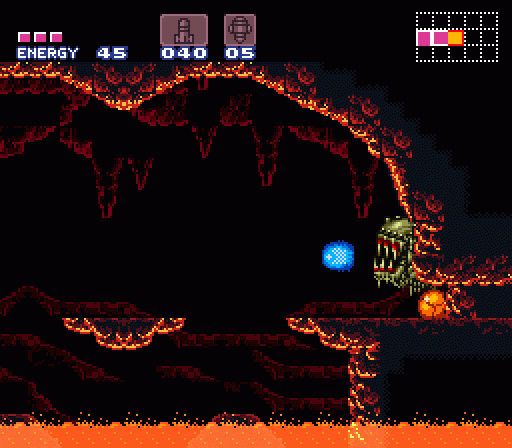
Your next move is blocked off by a slightly hidden obstruction beneath a wall-mounted monster, but once again the level design does a good job of dropping hints for the direction you should take. After all, the other potential routes here are blocked off with clearly insurmountable obstacles: A one-way door switch on the wrong side of the door, a too-high jump to complete, a pile of blocks that can only be shattered with a tool you don’t currently possess.
So you roll under here and enter a tall room, at which point lava begins to rise. It climbs slowly, giving you plenty of time to race ahead of it.
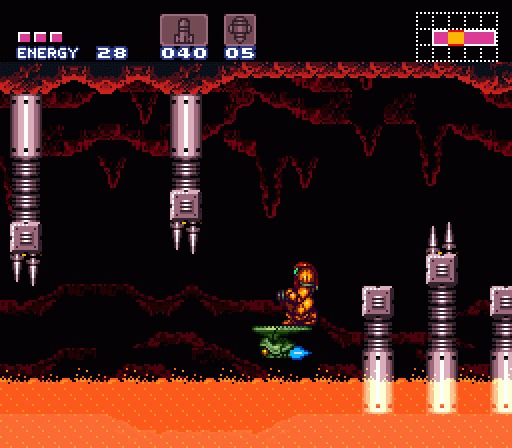
This leads to an interesting trap room full of gizmos that attempt to harm you: Rising spikes, descending doors, moving platforms that slowly descend into the magma as you ride them along. Like the flooding magma in the previous room, they’re pretty easy to bypass — and like the magma trap, these elements will be repeated in more difficult scenarios in the near future. These low-challenge sequences serve to give you a taste of things to come.
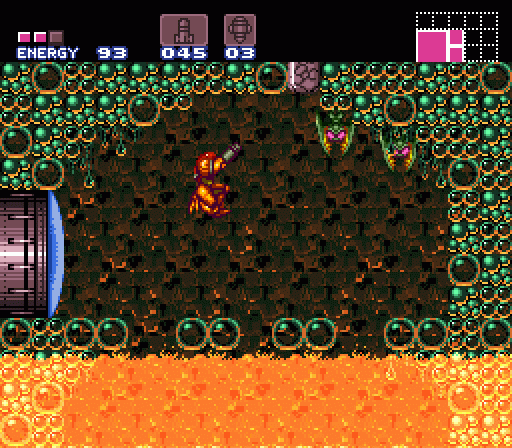
This sequence of traps leads you back to the chamber with all the exits, but now you’re up in an area that you couldn’t reach before. This leads to a room that appears empty, but which actually contains a hidden passage in the ceiling. How would you luck into locating such an obscure route? Well, handily, there’s a trio of Skrees mounted to the ceiling, and you’re going to want to shoot them away before you enter the room so they don’t drop on you. In the process — especially if you grabbed the Spazer before — you’ll almost certainly reveal the destructible block with a stray shot. The game doesn’t actually give you the answer, but it makes sure you’ll find it in a way that makes you feel like you cleverly stumbled upon it yourself. It’s a microcosmic example of sharp game design.
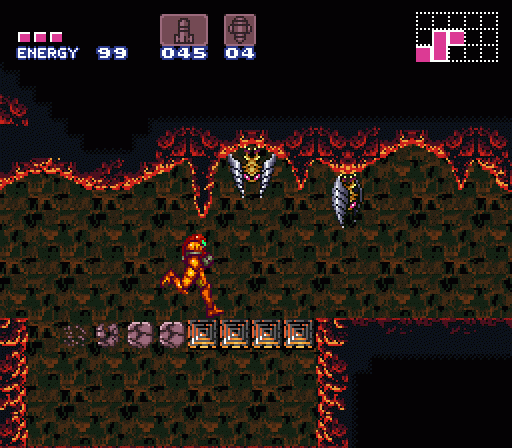
And that continues right into the next room with a series of collapsing bridges made of blocks that vanish as you walk across them. You’ve seen this sort of thing before — the blocks crumble away as you pass. If you’re walking, they’ll drop you right through the bridge into the little pits below. There’s nothing dangerous about this; it’s just a little inconvenient. But if you dash, well, you can run right over the pits with no trouble — and you’ll streak right past the bad guys, too.
But if you haven’t figured out the secret to dashing by now, you’re given explicit instructions at the end of the series of bridges, which is where the Speed Booster waits for you. The Speed Booster is one of the most subtle power-ups in the game; all it does is slightly boost the speed at which Samus runs. But this is just enough of a boost to slip past certain timed obstacles — and, as with all weapons and tools in Super Metroid, the boots work as both weapons and tools. Once you hit peak speed, Samus begin shining with power, and her body becomes deadly to the touch. Samus can smash through both “speed blocks” and enemies alike.
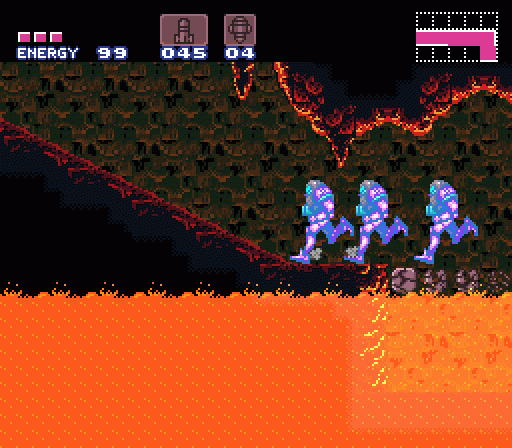
You’re forced to run here this time around, since magma begins to rise as soon as you exit the Speed Booster room — and much faster than it did in the previous instance. You have to retrace your steps across the falling bridges, and if you don’t run here you’ll never make it out alive.

And now it’s possible to backtrack to some of those areas where descending gates blocked your path — now you’re fast enough to streak past them to the areas belong. There’s one high up in Brinstar, but you can’t get back there yet. The one near the entrance to Norfair, on the other hand, is totally within reach.
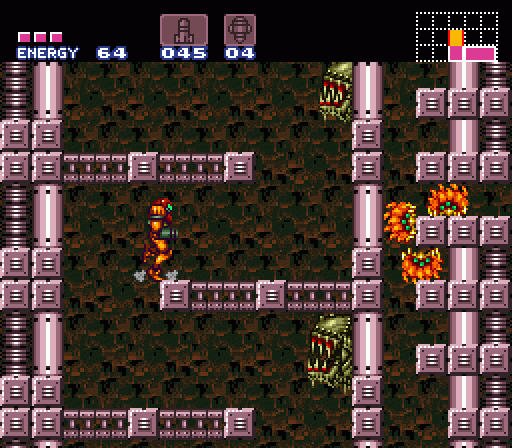
The far side of the gated chamber takes you to another winding shaft with those mounted alien heads on the walls, though this time there’s no magma to outrace. Instead, you’ll reach a room where you can’t possibly hope to proceed; the only way forward is through a small slot halfway up the wall. But since magma lines the floor and there’s this weird jumping thing next to the wall, you can’t bomb jump your way up.
Instead, you have to double back and drop down the narrow pipe along the right side of the monster room — a pipe that, handily, contains a small hole leading into another room. In case you miss it, a trio of little wall-walking critters wanders out of it right around the time you get there.
Remember how Metroid II caused the world to cease existing as soon as you scrolled it off the screen? Not only does Super Metroid retain persistence when something wanders off-screen, in some cases it even maintains continuity between discrete rooms of the world. The scuttlers here actually spawn in a separate room when you enter this shaft and are timed to walk into the main chamber right around the time you get close enough to see them appear. This happens in a few spots throughout the game — a bit of next-gen advancement harnessed in the employ of subtle hints.
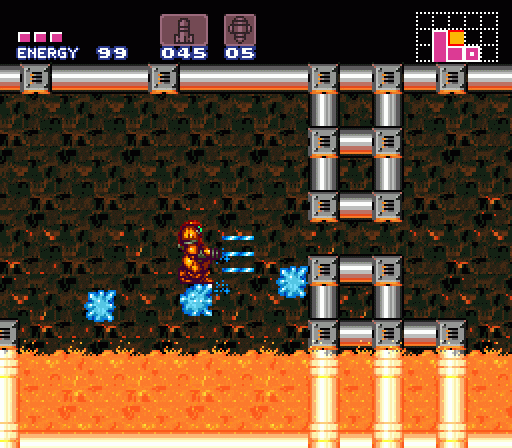
The hidden chamber where the fire guys come from contains a door leading to the Ice Beam, which works much the same as in previous Metroids. What makes it different here — and great — is that the Ice Beam no longer need be an either/or proposition. Once you pick up this weapon, it doesn’t overwrite the Spazer… it supplements it. So now you have a beam as powerful and wide as the Spazer, but also capable of freezing foes. And if you find the freeze effect annoying (since it forces you to shoot an enemy twice as many times in order to destroy it), you can turn it off in the powers menu screen. You can also turn off the Spazer, if for some reason you find increased power and a wider spread of beams detrimental to your play style.
The Ice Beam allows you to pass through the magma chamber above: You can freeze the jumpers and roll across them through the gap above the lava, returning to Norfair’s entry shaft.
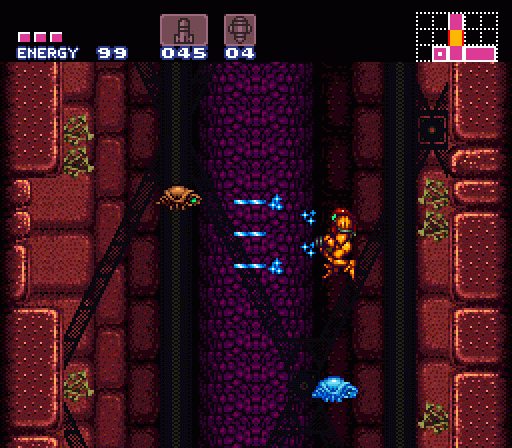
Finally, finally, you can leave Norfair again. The Ice Beam lets you freeze the Rippers drifting through the shaft you fell through down in the eastern portion of Brinstar. You have your basic tools now. Slowly, the game is beginning to open wide.
*strictly speaking* the Varia remains optional, but only if you are willing to race through Norfair and Ridley’s Lair at full speed. I don’t think anyone can pull it off in a regular speed-run though, only tool-assisted.
So, it’s not optional. You can glitch through Chrono Trigger in 10 minutes, but I wouldn’t consider that a viable strategy, either.
Hey Mr Parish you should watch the four person race of Super Metroid from AGDQ 2014. It is nuts.
http://www.twitch.tv/speeddemosarchivesda/b/494222408?t=7h51m20s
Or to total have your mind blown the 14% Complete 44 Minute run. The guy gets the gravity suit before the varia suit .
http://speeddemosarchive.com/SuperMetroid.html#any
It is kinda neat to watch people try to beat norfair/Ridley without a suit. One day some one will pull it off non tool assisted and it will be glorious.
For the rest of us, we need all the suits we can get.
Before leaving Norfair, players would usually battle Crocomire at this point. At least, I always did. One of the many memorial Boss encounters of that game. Or did you save him for later when coming back to go for Ridley?
Don’t you need either the Wave Beam or Power Bomb to get to Crocomire? Or did I forget about an alternate path?
The rooms with the green bubbles for walls always fired up my imagination because they look like giant cells. What if the lava in those rooms was some sort of blood, the rooms were giant blood vessels, each major zone was an organ and the planet was a gigantic organism? Maybe Norfair is the heart, Maridia is the stomach, Crateria is the teeth, Brinstar is the lungs (its plants respire), the wrecked ship is a wrecked ship, and Tourian is an artificial brain. It would be amazing if a future sequel used this concept deliberately.
As for enemies persisting through doors, did you know the original Metroid does this? If a Zeb or Zoomer flies or crawls into it when the screen is scrolling, it will go to the next room. It’s very impressive for an early game on a console that’s usually terrible at persistence.
Edit: Continuing the planet metaphor, the Metroids would be the immune system, equivalent of white blood cells.